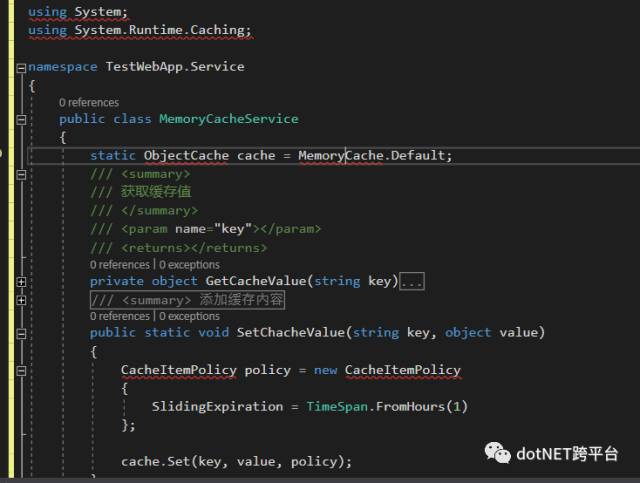对于传统的.NET Framework项目而言,System.Runtime.Caching命名空间是常用的工具了,其中MemoryCache类则常被用于实现内存缓存。
.NET Core 2.0暂时还不支持System.Runtime.Caching dll,这也就意味着MemoryCache相关代码不再起作用了。
但是好消息是,我们可以使用.NET Core 2.0的新API实现内存缓存功能,简单修改代码,解决不兼容问题。
解决方案
1.将旧代码导入项目中,如下:
using System;
using System.Runtime.Caching;
namespace TestWebApp.Service
{
public class MemoryCacheService
{
static ObjectCache cache = MemoryCache.Default;
/// <summary>
/// 获取缓存值
/// </summary>
/// <param name="key"></param>
/// <returns></returns>
private object GetCacheValue(string key)
{
if (key != null && cache.Contains(key))
{
return cache[key];
}
return default(object);
}
/// <summary>
/// 添加缓存内容
/// </summary>
/// <param name="key"></param>
/// <param name="value"></param>
public static void SetChacheValue(string key, object value)
{
if (key != null)
{
CacheItemPolicy policy = new CacheItemPolicy
{
SlidingExpiration = TimeSpan.FromHours(1)
};
cache.Set(key, value, policy);
}
}
}
}
导入后你会发现VS会提示无法找到System.Runtime.Caching命名空间,原有的代码无法直接编译使用。

2.添加对Microsoft.Extensions.Caching.Memory命名空间的引用,它提供了.NET Core默认实现的MemoryCache类,以及全新的内存缓存API
using Microsoft.Extensions.Caching.Memory;
3.改写代码,使用新的API实现内存缓存功能
初始化缓存对象方式改写前:
static ObjectCache cache = MemoryCache.Default;
初始化缓存对象方式改写后:
static MemoryCache cache = new MemoryCache(new MemoryCacheOptions());
读取内存缓存值方式变化:
private object GetCacheValue(string key)
{
if (key != null && cache.Contains(key))
{
return cache[key];
}
return default(object);
}
改写后:
private object GetCacheValue(string key)
{
object val = null;
if (key != null && cache.TryGetValue(key, out val))
{
return val;
}
else
{
return default(object);
}
}
设定内存缓存内容方式变化:
public static void SetChacheValue(string key, object value)
{
if (key != null)
{
CacheItemPolicy policy = new CacheItemPolicy
{
SlidingExpiration = TimeSpan.FromHours(1)
};
cache.Set(key, value, policy);
}
}
修改后:
public static void SetChacheValue(string key, object value)
{
if (key != null)
{
cache.Set(key, value, new MemoryCacheEntryOptions
{
SlidingExpiration = TimeSpan.FromHours(1)
});
}
}
结论
在使用了Microsoft.Extensions.Caching.Memory下的新API改写了旧代码后,你会发现原有的各种内存缓存超时策略全都是有对应新API的,包括AbsoluteExpiration, SlidingExpiration等等。
所以我们还是可以很轻松的使用.NET Core新API简单改动下下就能重用现有绝大部分旧代码,将其迁移过来继续起作用。
迁移后的完整代码如下:
using Microsoft.Extensions.Caching.Memory;
using System;
namespace TestMemoryCacheWebApp.Services
{
public class MemoryCacheService
{
static MemoryCache cache = new MemoryCache(new MemoryCacheOptions());
/// <summary>
/// 获取缓存值
/// </summary>
/// <param name="key"></param>
/// <returns></returns>
private object GetCacheValue(string key)
{
object val = null;
if (key != null && cache.TryGetValue(key, out val))
{
return val;
}
else
{
return default(object);
}
}
/// <summary>
/// 添加缓存内容
/// </summary>
/// <param name="key"></param>
/// <param name="value"></param>
public static void SetChacheValue(string key, object value)
{
if (key != null)
{
cache.Set(key, value, new MemoryCacheEntryOptions
{
SlidingExpiration = TimeSpan.FromHours(1)
});
}
}
}
}
相关文章:
.NET应用迁移到.NET Core(一)
.NET应用迁移到.NET Core(二)风险评估
.NET应用迁移到.NET Core(三)从商业角度看移植过程
.NET应用迁移到.NET Core--调查案例
迁移传统.net 应用到.net core [视频]
应用工具 .NET Portability Analyzer 分析迁移dotnet core
.net core 2.0学习笔记(一):开发运行环境搭建
.net core 2.0学习笔记(二):Hello World & 进阶
度量.net framework 迁移到.net core的工作量
迁移.net framework 工程到.net core
程序配置&ConfigurationManager
.NET Core 2.0迁移技巧之web.config配置文件
原文地址:http://www.cnblogs.com/mantgh/p/7429551.html
.NET社区新闻,深度好文,微信中搜索dotNET跨平台或扫描二维码关注




)

坑)







)



![jzoj1266,P1879-[USACO06NOV]玉米田Corn Fields【状态压缩,dp】](http://pic.xiahunao.cn/jzoj1266,P1879-[USACO06NOV]玉米田Corn Fields【状态压缩,dp】)

